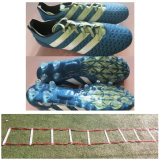The purpose of this study was to describe the epidemiology of Korean collegiate injuries during 2015. Collegiate student-athletes(n=167) in six sports (badminton, baseball, basketball, rugby, taekwondo, and volleyball) participating in all practices and games during pre-season, in-season, and post-season were tracked via the injury surveillance system(rate, location, type, and cause of musculoskeletal injury). Injury rate for 1000 athlete-exposure(AE) and 1000 time-exposure(TE) were calculated with 95% confidence intervals(CI). We captured a total of 961 injuries, a rate of 19.29/1000 AE(95% CI=18.07, 20.51) and 0.16/1000 TE(95% CI=0.15, 0.17). Commonly injured body locations were knee(17.5%, n=168), thigh(16.1%, n=155), ankle(12.1%, n=116), and finger(8.4%, n=81). Injuries were mostly diagnosed as contusion(40.1%, n=385), ligament sprain(21.1%, n=203), and laceration/abrasion/skin injury(13.5%, n=130). Common causes were contact with another athlete(44.6%, n=429), contact with moving object (12.7%, n=122), overuse/atraumatic(11.9%, n=114), and contact with non-yielding object(9.4%, n=90).
PURPOSE This study explores injury attributions accepted by serious football participants, specifically intermediate and advanced players. METHODS Utilizing Q methodology, 25 Q-samples and 33 P-samples were selected, and Q-classification was conducted. Principal component factor analysis through the PQ method (vers. 2.35) was employed for data analysis, and types were interpreted and named based on the Q-sample with a Z-score of ±1.0 or higher. RESULTS Results categorized injury attributions accepted by the participants into four types: 'Type I: Facility/ Human Resource Responsibility Type,” 'Type II: Luck/Other Responsibility Type,” 'Type III: Self Responsibility Type,” and 'Type IV: Insufficient Safety Education.” This study provided academic and policy discussions by reclassifying four types according to their internal and external location and controllability. CONCLUSIONS In conclusion, this study emphasizes the relevance of all four types of injury attribution to policy considerations. Ensuring participants' right to participate in safe and enjoyable sports requires addressing facilities/human resources, education, and insurance as major policy components of sports safety.
Purpose The purpose of this study is to examine the location, rate, cause, and types of injuries according to the injured area by age and sports in female athletes. Methods The subject of the study was 426 female athletes who were registered as combat sports(Judo, Taekwondo, Fencing) athletes at the Korean Sports & Olympic Committee. We collected the data via online questionnaires, and conducted a frequency analysis using R statistics program. Results As a result, 51.4% of athletes experienced injuries in the past year, and the highest injury rate was shown in Taekwondo-University(0.43) during competition and Taekwondo-Professional(5.55) during training. The cause of injuries during competition was mainly due to 'as a result of me or the opponent's hittings, skills, or fouls' among internal factors, and 'recurrent injuries' among external factors. Among internal factors during training except for torso area and professional athletes, most of the injuries were also caused by ‘as a result of me or the opponent's hittings, skills, or fouls’ and ‘recurrent injuries’ among external factors. The frequency of injury was the highest in the lower extremity area across all age groups. The most frequently injured area, in the case of Judo, is skin-bleeding in the head, skin-bruise, muscle-inflammation, bone-fracture, spondylopathy(disc, stenosis, etc.) in the torso, muscle-inflammation in the upper extremity, ligament-sprain, rupture in the lower extremity. Taekwondo athletes had skin-bruise in the head, upper and lower extremities, and muscle-inflammation in the torso area, as the frequent injury cases, and Fencing athletes had all skin-bruise regardless of injuries. Conclusions The results of this study will be used to take measures for preventing injuries or to change training programs.
Purpose Incidence and prevalence of Korean teenager cheerleading injuries were surveyed. Methods A total of 769 junior cheerleaders who participated in National Sport Cheerleading Competitions responded to a questionnaire, and 435 reported experiences of injuries. Results Risk factors for injury included older age (p<0.001), increased experience (p<0.001), and higher BMI (p<0.05). The most frequent injury occurred at wrist, ankle, knee, shoulder and waist. And the most responded types of injury were muscular pain and contusion. Cheerleading experience affected on injury prevalence. They were injured when they perform Elevator (<0.5 yrs), Cradle (0.5-1 yrs), Cradle and Basket toss (1-2 yrs), Cradle and Pyramid (2-3 yrs). These techniques involved in bodily movements of going up and cradle. About 56% of injury was treated at home or not treated at all, and 60% of injury was either self-treated or not intervened. And only 32% of cheerleaders practiced on a formal mattress. Conclusion Safety measures for these youth cheerleaders are necessary and guidelines for securing safety and preventing and treating injuries for these population are urgent.

Purpose The purpose of this study was to investigate the lower extremity muscles activity during forward side step by soccer field ground types. Methods Fifteen elite high school soccer players participated in this study. Muscle activation patterns were recorded at 2000 Hz during forward side step task. Surface EMG of the tibialis anterior(TA), soleus(SOL), medial gastrocnemius(MG), lateral gastrocnemius(LG), peroneus brevis(PB) muscle was recorded, and the root mean square of the EMG was normalized, using a maximum voluntary isometric contraction(%MVIC). One-way repeated ANOVA was used for comparison among three soccer field ground types(natural grass, artificial turf, hard ground). Results Artificial turf displayed greater soleus and peroneus brevis activities compare to natural grass during forward side step task. Conclusions The relationship between increased soleus and peroneus brevis activation and greater incidence of injury in artificial turf versus natural grass requires further study. Soccer players routinely training on artificial turf for prolonged periods should be carefully monitored.


PURPOSE The purpose of this study was to investigate the current injury status and traits, including damage area, cause of damage based on the situation, and type of occurrence by age group for middle and high schools, university, and professional athletes, in record competition sports (swimming, track and field, and weightlifting). METHODS The study included 503 athletes enrolled in the Korean Sport & Olympic Committee in 2020, and an online survey was conducted using the R statistical program. RESULTS Approximately 38.4% athletes suffered injuries with weightlifting (0.81 times at university) and weightlifting (7.02 times at university) during training. The lower extremities were the most affected areas in all age groups (53.8% in middle school, 48.6% in high school, 44.4% in university, and 47.4% in professional). The causes of damage found to occur most frequently were ‘lack of physical strength, overuse or lack of rest, and recurrence’ and external factors, including ‘facility programs and weather problems.’ The results showed that internal factors during training were mostly associated with ‘overuse or lack of rest and excessive attempts at skills’, while external factors were found to occur in ‘weather problems’. According to the classification of each event, the top priority of frequent damage according to the damaged area was skin bleeding of the head in swimming and muscle inflammation in the torso and upper and lower extremities. Track and field resulted in muscle inflammation in the head, torso, and upper and lower extremities. Weightlifting caused damage to the head and torso, resulted in spinal diseases (disc, spinal stenosis, etc.), and muscle inflammation in the upper and lower extremities. CONCLUSIONS This study highlighted changes in the training environment and training environment, including level-specific physical training, reinforcement programs, scientific access to specific skills, sufficient rest and recovery, and continuous improvement of facilities and equipment.

This study aimed to explore the types of traumatic event experienced by Volleyball players and then prepare to take-off the serial process of posttraumatic growth to schematize a causal network by organizing the factors for overcoming adversity. Participants experiences were collected by distributing open-ended questionnaires to 77 professional Women's volleyball players in 2013-2014 and collected data was categorized by inductive content analysis. These results were schematized by the causal network. As a result of the study, according to the trauma were categorized into four general areas: member conflict, competence loss, physical injury, and coach conflict and the emotions relative to the trauma were categorized into four general areas: powerlessness, pressure, dejection, and hostility also coping factors were categorized into three general areas: social support, intervention strategies, and psychological control. Finally, positive growth emerged as psychological leap, performance improvement, psychological maturity, and emotional stability. And as a result of the categorized study, bring about a better understanding to the posttraumatic growth by causal network. Based on the study results, that volleyball players experienced a positive development on themself after overcoming the problem that they had suffered psychological scars from a traumatic event. In doing so, they contributed to the formation of resources that helped them in their positive lives. In this regard, this study expects to provide the players who have been scratched in mind because of the traumatic experience.





PURPOSE This study aimed to characterize the kinematic variables of stair climbing in adult women by analyzing the effects of varying heel heights on their climbing behavior. METHODS A total of 24 adult women (age: 22.08±1.28years; height: 160.43±4.30cm; weight: 54.10±6.39kg) participated in this study. All subjects wore the same type of high heels with heights of 1cm, 5cm, and 7cm while performing stair climbing on stairs measuring 18cm in height. Ten infrared cameras (200Hz) and ground reaction force sensors (1000Hz) were set up on the stairs, along with an 8-channel electromyography system (1000Hz) to analyze the maximum moments at each joint and the muscle activation during stair climbing. Data were analyzed using IBM SPSS Statistics version 27.0 (IBM., USA). All variables underwent the Shapiro–Wilk normality test, with repeated measure analysis of variance or the Friedman test applied based on the results. Post hoc tests were conducted using the LSD test or Wilcoxon signed-rank test. RESULTS Our study found four key findings. First, a significant decrease in maximum dorsiflexion, plantarflexion, inversion, and adduction moments of the ankle joint was observed with increasing heel height. Second, the maximum extension, adduction, and external rotation moments of the knee joint significantly decreased as heel height increased, while the maximum abduction and internal rotation moments significantly increased. Third, the maximum flexion, extension, and abduction moments of the hip joint significantly increased with higher heel heights. Fourth, muscle activity of the rectus femoris, vastus medialis, vastus lateralis, semitendinosus, and gastrocnemius decreased with increasing heel height compared to walking; however, muscle activity in the tensor fasciae latae increased. CONCLUSIONS The results of this study suggest that as heel height increases, the risk of injury may rise due to limited ankle use and increased moments in the knee and hip joints, potentially leading to muscle strength imbalances in adult women, particularly through the overuse of specific muscles.